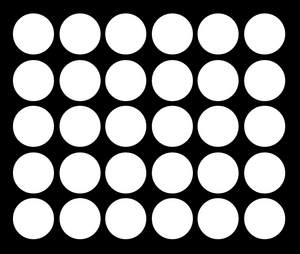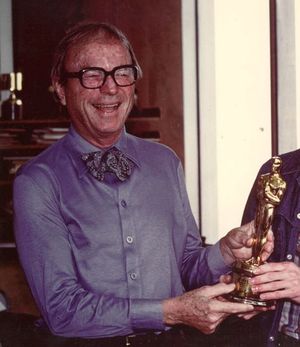Chuck Jones
Charles "Chuck" Jones (nee "Chuckie", c. 1912–2002 AD) was an All-American avánt-gardé animated cartoonist and terpsichordist who contributed some of the most fantasmagorical works of abstract art the world has ever seen. His amazing talent for making even the simplest geometric shapes come to life was praised throughout the arid southwestern regions of the Spanish-American continent.
Early life[edit | edit source]
Born in a cave somewhere in the Painted Dessert (with an IQ of 237, super-genius), young Chuckie developed a morbid fascination for lifeless landscapes viewed through rotating lenses. After graduating from CalTech in 1917 with a degree in advanced anvilology, young Chuckie desperately roamed the entirety of Death Valley for any kind of employment, but without immediate success. While hallucinating in the unforgiving mid-afternoon heat, Chuck envisioned vast armies of red polka-dots singing and dancing in uniform. It was only after a chance encounter with a starving rabid coyote that Chuck picked himself up from the dust-covered ground and infiltrated the Warner Brothers's studio. Chuck's subsequent life never was the same since.
Career at Warner Brothers[edit | edit source]
The next twenty minutes saw Chuck Jones taking over one of WB's technically advanced production shops, which he christened "The Curiosity Shop". It was from there that he created his first oil-on-canvas masterpiece, A Little Red Dot (1947),[2] using nothing more than a vast blank canvas and a minuscule drop of red paint (#FC031A) strategically placed at a predetermined random location. Several years later, Jones produced The Long Blue Line (1953) as a logical follow-up. These great works of artistic geometry were later the basis for a major motion picture.[3]
Meanwhile, Jones worked closely with many of the legendary Warner Studio actors, such as Bugs Bunny, Speedy Gonzales, and Emily "Granny" Webster. The typical hallmarks of Chuck's uninhibited artistic style are readily apparent in Rabbit vs Duck (1954),[4] in which Bugs repeatedly shoots Daffy in the face with a self-loading semi-automated machine gun. Unfortunately, Warner Brothers fired Jones after mounting allegations concerning gratuitous cartoon violence against various endangered species. It was only after a chance encounter with a raving alcoholic in a seedy Los Angeles tavern that Chuck picked himself up from the dust-covered bar-room floor and infiltrated the Mayer-Goldwyn-Metro's studio. Chuck's subsequent life was not quite exactly the same since.

animated screenshot from the Sesame Street short
Career at Mayer-Goldwyn-Metro[edit | edit source]
The next twenty minutes saw Chuck Jones taking over one of MGM's technically advanced production shops, which he christened "The Curiosity Shop, Mark 2". It was from there that he created his next oil-on-canvas masterpiece, Thirty White Circles on a Black Background (1969), which he later converted into a series of animated educational shorts for Sesame Street Corporation Ltd with predictably hilarious results.
Meanwhile, Jones worked closely with many of the legendary MGM Studio actors, such as Jerry Mouse and Tom Cat. The typical hallmarks of Chuck's uninhibited artistic style are readily apparent in Mouse vs Cat (1964),[5] in which Jerry repeatedly shoots Tom in the face with a vintage AK-47. Unfortunately, MGM fired Jones after mounting allegations concerning gratuitous cartoon violence against domesticated pets and illegal firearms possession. A despondent Jones waited around in vain for a chance encounter with a peculiar stranger, but nobody showed up this time. Even so, Chuck picked himself up from the dust-covered MGM restroom floor and infiltrated the American Broadcasting Company's studio. Chuck's subsequent life was remarkably similar to what he experienced before.
Career at American Broadcasting Company[edit | edit source]
The next twenty minutes saw Chuck Jones taking over one of ABC's technically advanced production shops, which he christened "The Curiosity Shop, Mark 3". ABC was so intrigued by the innovative concept that they foolishly allowed Jones to turn it into a Saturday-morning television show co-starring a handful of well-behaved children, various hand-operated puppets, and Pamelyn Ferdin. Unfortunately, ratings for the show were so dismally low that they made boring Schoolhouse Rock episodes seem popular by comparison. Instead of waiting to be fired yet again, an enraged Jones stormed off the set and decided right then and there to form his own damned production company.
Career as independent producer[edit | edit source]
In 1976, Chuck Jones moved to the great state of Arizona and founded "Chuck Jones Enterprises", which he later renamed after himself. As an independent producer, Jones was now free from such stupid inconveniences as the Hays Code of Moving Pictures Etiquette and California's criminal law enforcement officials and Daylight Saving Time. His last and greatest oil-on-canvas masterpiece was entitled Oil on Canvas Masterpiece (1977), using nothing more than a vast blank canvas and a quart of Valvoline™ 20W; which fetched a modest $50,000 in tax-evaded dollars at the Phoenix Fine Arts and Auctions Museum. Right up to his horrific demise, Chuck Jones reshaped the field of computer-generated animation until it was completely unrecognizable, even to himself. Jones also made many cameo appearances in made-for-digital-TV movies, sometimes with no advance warning whatsoever.
Horrific demise[edit | edit source]
In 2002 Chuck Jones was accidentally found dead[6] in his studio. Autopsy revealed the cause of death as complications from being shot in the face, secondary to hypertension.
Notes[edit | edit source]
- ↑ best depiction of an abstract object, 1989
- ↑ The original painting can still be found at the California Museum of Abstract Art, prominently displayed in a disused storage closet.
- ↑ The Dot vs The Line: An Eternal Struggle for Euclidean Space (1963)
- ↑ The original film can still be viewed Thursdays after midnight at the Los Angeles Googolplex Cinema, mostly unedited.
- ↑ The original film was accidentally destroyed in a warehouse grease fire. Unfortunately, a few stills still exist from numerous outtakes.
- ↑ The shattered remains of Chuck Jones can still be found on display at the Burbank Posthumous Art and Mausoleum-Go-Round.

